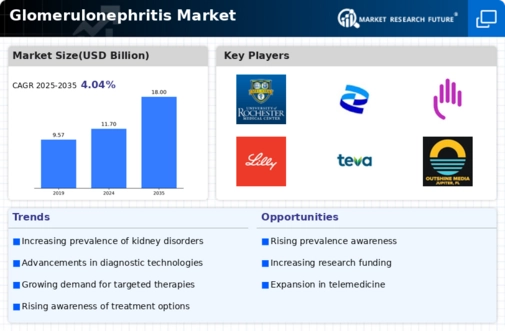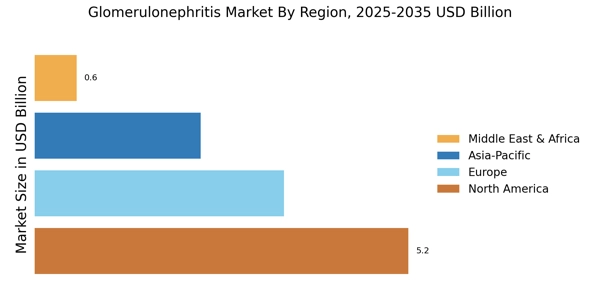Government Initiatives and Funding
Government initiatives and funding play a significant role in shaping the Glomerulonephritis Market. Various health authorities are recognizing the burden of kidney diseases, including glomerulonephritis, and are allocating resources to research and treatment programs. Increased funding for clinical trials and research initiatives is likely to accelerate the development of new therapies and diagnostic tools. Furthermore, government-sponsored awareness campaigns can enhance public knowledge about kidney health, potentially leading to earlier detection and treatment of glomerulonephritis. These initiatives not only support the healthcare system but also create a conducive environment for the growth of the Glomerulonephritis Market. As governments continue to prioritize kidney health, the market is expected to experience positive momentum driven by enhanced research and development efforts.
Innovations in Therapeutic Approaches
Innovations in therapeutic approaches are significantly shaping the Glomerulonephritis Market. The development of novel immunosuppressive therapies and biologics has transformed treatment paradigms, offering new hope for patients with this complex condition. For instance, recent advancements in targeted therapies have shown promise in improving patient outcomes, potentially reducing the need for dialysis or transplantation. The market is witnessing a shift towards personalized medicine, where treatments are tailored to individual patient profiles, enhancing efficacy and minimizing side effects. This trend is likely to attract investment and research efforts, further stimulating the Glomerulonephritis Market. As pharmaceutical companies continue to explore new drug candidates and treatment regimens, the landscape of glomerulonephritis management is expected to evolve, creating opportunities for growth and innovation.
Technological Advancements in Diagnostics
Technological advancements in diagnostics are transforming the Glomerulonephritis Market. The introduction of innovative diagnostic tools, such as advanced imaging techniques and biomarker discovery, is enhancing the accuracy and speed of glomerulonephritis diagnosis. These technologies enable healthcare providers to identify the condition at earlier stages, which is crucial for effective management and treatment. The market is witnessing a surge in demand for these advanced diagnostic solutions, as they facilitate timely interventions and improve patient outcomes. Moreover, the integration of artificial intelligence and machine learning in diagnostic processes is expected to further streamline the identification of glomerulonephritis, potentially leading to more personalized treatment approaches. As these technologies continue to evolve, they are likely to play a pivotal role in shaping the future of the Glomerulonephritis Market.
Increasing Incidence of Glomerulonephritis
The rising incidence of glomerulonephritis is a pivotal driver for the Glomerulonephritis Market. Recent data indicates that the prevalence of this condition has been steadily increasing, with estimates suggesting that approximately 20% of chronic kidney disease cases are attributed to glomerulonephritis. This trend is likely influenced by factors such as an aging population and the growing prevalence of risk factors like hypertension and diabetes. As more individuals are diagnosed, the demand for effective treatment options and management strategies is expected to surge, thereby propelling the market forward. Furthermore, the increasing awareness of kidney health among healthcare professionals and patients alike is anticipated to contribute to the growth of the Glomerulonephritis Market, as early diagnosis and intervention become more commonplace.
Rising Awareness and Education Initiatives
Rising awareness and education initiatives regarding kidney health are crucial drivers for the Glomerulonephritis Market. Various organizations and healthcare providers are increasingly focusing on educating the public about the symptoms and risks associated with glomerulonephritis. Campaigns aimed at promoting kidney health and encouraging regular check-ups are likely to lead to earlier diagnosis and treatment. This heightened awareness may result in a greater number of patients seeking medical attention, thereby increasing the demand for diagnostic and therapeutic options. Additionally, educational programs targeting healthcare professionals are essential for improving the understanding of glomerulonephritis management, which could enhance patient care and outcomes. As awareness continues to grow, the Glomerulonephritis Market is expected to benefit from an influx of patients seeking effective treatments.


















Leave a Comment